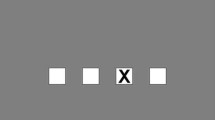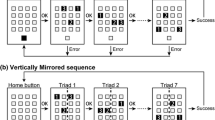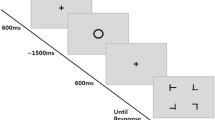Abstract
As an automatic process, implicit learning effects have been characterized as inflexible and largely tied to the reinstatement of the acquisition context. However, implicit learning transfer has been observed under certain conditions, depending on the changes introduced between training and transfer. Here, we assess the hypothesis that transfer is specifically hindered by those changes that increase the control demands required by the orienting task with respect to those faced over training. Following on previous results by Jiménez et al. (J Exp Psychol Learn Memory Cognit 32(3):475–490, 2006), which showed that the learning acquired over a standard serial reaction time task was not transferred to conditions requiring a more demanding search task, we explored the impact of symmetrical training and transfer conditions, and showed that sequence learning survived such transfer. Four additional experiments designed to assess transfer to either lower or higher control demands confirmed that the expression of learning was selectively hindered by those transfer conditions requiring higher levels of control demands. The results illustrate how implicit sequence learning can be indirectly subjected to cognitive control.





Similar content being viewed by others
Notes
Notice that, in the referenced studies, the normalization procedure was conducted to control for between-participants differences in RT baselines, and thus, they normalized the scores on the basis of the individual means and standard deviations computed over the whole task. In the present conditions, because the source of different baselines was the task used in some blocks, the normalization was conducted in terms of the individual mean and standard deviation computed for each block.
References
Abrahamse, E. L., Jiménez, J., Verwey, W. B., & Clegg, B. A. (2010). Representing serial action and perception. Psychonomic Bulletin & Review, 17, 603–623.
Abrahamse, E. L., Van Der Lubbe, R. H., & Verwey, W. B. (2008). Asymmetrical learning between a tactile and visual serial RT task. The Quarterly Journal of Experimental Psychology, 61(2), 210–217.
Abrahamse, E. L., & Verwey, W. B. (2008). Context dependent learning in the serial RTs task. Psychological Research, 72, 397–404.
Berry, D. C., & Dienes, Z. (1993). Implicit learning: Theoretical and practical issues. Hillsdale, NJ: Lawrence Erlbaum.
Botvinick, M. M., Braver, T. S., Barch, D. M., Carter, C. S., & Cohen, J. D. (2001). Conflict monitoring and cognitive control. Psychological Review, 108(3), 624–652.
Christ, S. E., White, D. A., Mandernach, T., & Keys, B. A. (2001). Inhibitory control across the life span. Developmental Neuropsychology, 20(3), 653–669. https://doi.org/10.1207/S15326942DN2003_7.
Cleeremans, A., & Jiménez, L. (2002). Implicit learning and consciousness: A graded, dynamic perspective. In A. Cleeremans & R. French (Eds.), Implicit learning and consciousness: An empirical, philosophical, and computational consensus in the making (pp. 1–40). Hove, East Sussex: Psychology Press.
Clegg, B. A. (2005). Stimulus-specific sequence representation in serial reaction time tasks. The Quarterly Journal of Experimental Psychology, 58(6), 1087–1101.
Cohen, J.D. (2017). Cognitive control: Core constructs and current considerations. In T. Egner (Ed.) The Wiley handbook of cognitive control (pp. 3–28). Hoboken, New Jersey: Wiley-Blackwell.
Cohen, J. D., Aston-Jones, G., & Gilzenrat, M. S. (2004). A systems-level perspective on attention and cognitive control: Guided activation, adaptive gating, conflict monitoring, and exploitation vs. exploration, chapter 6. In M. I. Posner (Ed.), Cognitive cognitive neuroscience of attention (pp. 71–90). New York, NY: The Guilford Press.
Cohen, A., Ivry, R. I., & Keele, S. W. (1990). Attention and structure in sequence learning. Journal of Experimental Psychology: Learning, Memory and Cognition, 16, 17–30.
D’Angelo, M. C., Jimenez, L., Milliken, B., & Lupianez, J. (2013). On the specificity of sequential congruency effects in implicit learning of motor and perceptual sequences. Journal of Experimental Psychology: Learning, Memory and Cognition, 39(1), 69–84. https://doi.org/10.1037/a0028474.
Deroost, N., & Soetens, E. (2006). Spatial processing and perceptual sequence learning in SRT tasks. Experimental Psychology, 53(1), 16–30.
Deroost, N., Vandenbossche, J., Zeischka, P., Coomans, D., & Soetens, E. (2012). Cognitive control: A role for implicit learning? Journal of Experimental Psychology: Learning, Memory, and Cognition, 38(5), 1243–1258.
Dienes, Z., & Berry, D. C. (1997). Implicit learning: Below the subjective threshold. Psychonomic Bulletin & Review, 4, 3–23.
Fendrich, D. W., Gesi, A. T., Healy, A. F., & Bourne, L. E., Jr. (1995). The contribution of procedural reinstatement to implicit and explicit memory effects in a motor task. In A. F. Healy & L. E. Bourne Jr. (Eds.), Learning and memory of knowledge and skills: Durability and specificity (pp. 66–94). Thousand Oaks, CA: Sage Publications Inc.
Garavan, H., Ross, T. J., Murphy, K., Roche, R. A., & Stein, E. A. (2002). Dissociable executive functions in the dynamic control of behavior: Inhibition, error detection, and correction. Neuroimage, 17(4), 1820–1829.
Gratton, G., Coles, M. G., & Donchin, E. (1992). Optimizing the use of information: Strategic control of activation of responses. Journal of Experimental Psychology: General, 121(4), 480–506.
Healy, A. F., Wohldmann, E. L., & Bourne, L. E. (2005). The procedural reinstatement principle: Studies on training, retention, and transfer. In A. F. Healy (Ed.), Experimental cognitive psychology and its applications (pp. 59–72). Washington, DC: American Psychological Association.
Hoyndorf, A., & Haider, H. (2009). The “Not Letting Go” phenomenon: Accuracy instructions can impair behavioral and metacognitive effects of implicit learning processes. Psychological Research, 73, 695–706.
Inquisit 1.31 [Computer software]. (2002). Seattle, WA: Millisecond Software.
Janacsek, K., Fiser, J., & Nemeth, D. (2012). The best time to acquire new skills: Age-related differences in implicit sequence learning across the human lifespan. Developmental Science, 15, 496–505. https://doi.org/10.1111/j.1467-7687.2012.01150.x.
Jiménez, L., Lupiáñez, J., & Vaquero, J. M. (2009). Sequential congruency effects in implicit sequence learning. Consciousness and Cognition, 18(3), 690–700.
Jiménez, L., & Méndez, C. (1999). Which attention is needed for implicit sequence learning? Journal of Experimental Psychology: Learning, Memory, and Cognition, 25(1), 236–259. https://doi.org/10.1037/0278-7393.25.1.236.
Jiménez, L., & Méndez, C. (2001). Implicit sequence learning with competing explicit cues. Quarterly Journal of Experimental Psychology Section A: Human Experimental Psychology, 54(2), 345–369. https://doi.org/10.1080/713755964.
Jiménez, L., & Méndez, A. (2013). It is not what you expect: Dissociating conflict adaptation from expectancies in a stroop task. Journal of Experimental Psychology: Human Perception and Performance, 39(1), 271–284.
Jiménez, L., Vaquero, J. M. M., & Lupiáñez, J. (2006). Qualitative differences between implicit and explicit sequence learning. Journal of Experimental Psychology: Learning, Memory, and Cognition, 32(3), 475–490.
Jiménez, L., & Vázquez, G. A. (2005). Sequence learning under dual-task conditions: Alternatives to a resource-based account. Psychological Research, 69, 352–368.
Keele, S. W., Jennings, P., Jones, S., Caulton, D., & Cohen, A. (1995). On the modularity of sequence representation. Journal of Motor Behavior, 27, 17–30.
Klapp, S. T. (2007). Nonconscious control mimics a purposeful strategy: Strength of Stroop-like interference is automatically modulated by proportion of compatible trials. Journal of Experimental Psychology: Human Perception and Performance, 33(6), 1366–1376.
Koch, I. (2007). Anticipatory response control in motor sequence learning: Evidence from stimulus–response compatibility. Human Movement Science, 26(2), 257–274.
Logan, G. D., Taylor, S. E., & Etherton, J. L. (1996). Attention in the acquisition and expression of automaticity. Journal of Experimental Psychology: Learning, Memory, and Cognition, 22(3), 620–638.
Menon, V., Adleman, N. E., White, C. D., Glover, G. H., & Reiss, A. L. (2001). Error-related brain activation during a Go/NoGo response inhibition task. Human Brain Mapping, 12(3), 131–143.
Moors, A., & De Houwer, J. (2006). Automaticity: A theoretical and conceptual analysis. Psychological Bulletin, 132(2), 297–326.
Neal, A., & Hesketh, B. (1997). Episodic knowledge and implicit learning. Psychonomic Bulletin & Review, 4, 24–37.
Nissen, M. J., & Bullemer, P. (1987). Attentional requirements of learning: Evidence from performance measures. Cognitive Psychology, 19, 1–32.
Reber, A. S. (1993). Implicit learning and tacit knowledge: An essay on the cognitive unconscious. New York: Oxford University Press.
Reber, P. J., Knowlton, B. J., & Squire, L. R. (1996). Dissociable properties of memory systems: Differences in the flexibility of declarative or non-declarative knowledge. Behavioral Neuroscience, 110, 861–871.
Reed, J., & Johnson, P. (1994). Assessing implicit learning with indirect tests: Determining what is learned about sequence structure. Journal of Experimental Psychology: Learning, Memory, and Cognition, 20, 585–594.
Ruitenberg, M. F., De Kleine, E., Van der Lubbe, R. H., Verwey, W. B., & Abrahamse, E. L. (2012). Context-dependent motor skill and the role of practice. Psychological Research, 76(6), 812–820.
Schneider, W., Eschmann, A., & Zuccolotto, A. (2002). E-Prime user´s guide. Pittsburgh, PA: Psychology Software Tools.
Schvaneveldt, R. W., & Gomez, R. L. (1998). Attention and probabilistic sequence learning. Psychological Research, 61, 175–190.
Simon, J. R. (1969). Reactions toward the source of stimulation. Journal of Experimental Psychology, 81, 174–176.
Simon, J. R., & Wolf, J. D. (1963). Choice reaction time as a function of angular stimulus-response correspondence and age. Ergonomics, 6(1), 99–105.
Song, J. H., & Bédard, P. (2015). Paradoxical benefits of dual-task contexts for visuomotor memory. Psychological Science, 26, 148–158. https://doi.org/10.1177/0956797614557868.
Stadler, M. A. (1989). On learning complex procedural knowledge. Journal of Experimental Psychology: Learning, Memory, and Cognition, 15, 1061–1069.
Vaquero, J. M. M., Jiménez, L., & Lupiáñez, J. (2006). The problem of reversals in assessing implicit sequence learning with serial reaction time tasks. Experimental Brain Research, 175, 96–109.
Verwey, W. B., & Clegg, B. A. (2005). Effector dependent sequence learning in the serial RT task. Psychological Research, 69(4), 242–251.
Willingham, D. B. (1999). Implicit motor sequence learning is not purely perceptual. Memory & Cognition, 27, 561–572.
Willingham, D. B., Nissen, M. J., & Bullemer, P. (1989). On the development of procedural knowledge. Journal of Experimental Psychology: Learning, Memory, and Cognition, 15(6), 1047–1060.
Willingham, D. B., Wells, L. A., Farrel, J. M., & Stemwedel, M. E. (2000). Implicit motor sequence learning is represented in response. Memory and Cognition, 28(3), 366–375.
Funding
This research was funded by the Spanish Ministerio de Economía, Industria y Competitividad with research grants to Luis Jiménez (PSI 2015-70990-P) and Juan Lupiáñez (PSI 2014-52764), and by the Spanish Ministerio de Ciencia e Innovación with a research grant to Juan Lupiáñez (PSI-2017-84926).
Author information
Authors and Affiliations
Corresponding author
Ethics declarations
Conflict of interest
The authors declare that they have no conflict of interest.
Ethical standards
All procedures performed in the study were in accordance with the ethical standards of the institutional and/or national research committee and with the 1964 Helsinki declaration and its later amendments or comparable ethical standards.
Informed consent
Informed consent was obtained from all individual participants included in the study.
Additional information
Publisher's Note
Springer Nature remains neutral with regard to jurisdictional claims in published maps and institutional affiliations.
Rights and permissions
About this article
Cite this article
Vaquero, J.M.M., Lupiáñez, J. & Jiménez, L. Asymmetrical effects of control on the expression of implicit sequence learning. Psychological Research 84, 2157–2171 (2020). https://doi.org/10.1007/s00426-019-01222-1
Received:
Accepted:
Published:
Issue Date:
DOI: https://doi.org/10.1007/s00426-019-01222-1




